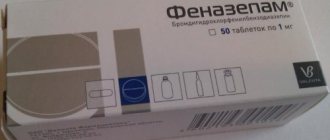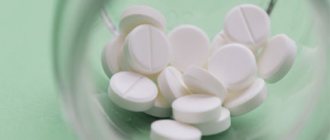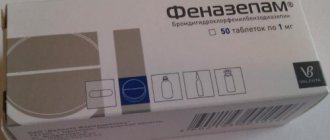- General information
- Historical facts
- Effect on the body
- How to recognize a drug addict
- Tests for Phenazepam
- How long does it stay in the body?
- How long do drug addicts live?
- Analogs
- How to speed up elimination at home
- Detoxification in hospital
- Perdose
- How to recognize and what to do
- Rehabilitation
- Coding
- Why you can’t undergo rehabilitation at home or on an outpatient basis
- Resocialization and work with codependents
- How to quit on your own
Attention! Drug use causes irreparable harm to health and poses a danger to life!
General information
The drug phenazepam is a typical tranquilizer. It is used to normalize sleep, combat anxiety, and relieve convulsive syndrome in epilepsy. Fenozepam is available in injection form or in tablets. All central effects of the drug are achieved through stimulation of benzodiazepine receptors.
The effect of the drug extends to the reticular formation, nonspecific centers of the thalamus and the amygdala complex. The muscle relaxant effect is based on the ability to block spinal reflexes. The tranquilizer is well absorbed through the gastrointestinal tract, after which it is metabolized in the liver and excreted by the kidneys.
Phenazepam is available without a prescription. Doctors sometimes prescribe it to improve sleep, relieve anxiety during performances or in extreme situations. The first aid kit always contains Phenazepam in injection form to relieve seizures in epilepsy or damage to the central nervous system.
All drugs from the benzoidazepine group cause sleep lasting up to 6-8 hours. But the longer the sleep, the stronger the drowsiness, fatigue and depression will be during the next day after taking the drug.
Taken from: Pharmacology, tenth edition by D.A. Kharkevich
The drug is not considered a drug, but addiction can develop from it. In addition, with each subsequent dose, to achieve the desired effect, it is necessary to increase the dose. If you increase the dosage without consulting a doctor, this will lead to acute drug poisoning with possible death.
Formation of physical dependence
A drug that enters the body regularly takes part in its biochemical processes. The psychoactive drug gradually begins to play the role of compounds that the body itself must produce, and dependence on it arises. Since these substances enter cells from the outside, the body's systems are reconfigured and stop producing them on their own.
And the longer the period of addiction, the more the biochemical processes of the addict change. If the next dose of a psychoactive substance does not enter the body, and the remnants of the previous dose are already excreted in the urine and sweat, then the patient experiences an acute deficiency in the drug that has already become “necessary”. This is how a state of drug withdrawal occurs.
Historical facts
The drug was invented in the 1970s. The developers who received the state order for the new medicine were the scientific directors of the departments of pharmacology from the Odessa Institute of Physics and Chemistry. After successful research and launch of the drug on the market, the group of voters received the USSR State Prize.
The peak use of the drug came at the end of the 80s, when facts of abuse of barbiturates were published and proven. Phenazepam and its analogues have become alternative drugs with similar effects but fewer adverse reactions.
Effect on the body
After the drug binds to benzodiazepine receptors and the reticular formation, the patient becomes calm and anxiety is eliminated. Then drowsiness appears, smoothly turning into sleep. In addition, the effect of the drug on limbic structures, reflex connections and the thalamus leads to the fact that the drug has the following effects:
- reduces feelings of fear;
- relieves irritability;
- increases emotional lability;
- reduces the manifestation of phobias;
- relieves alcohol and drug withdrawal syndrome;
- relieves muscle spasms;
- prevents nervous tics.
But you should be careful when using Phenazepam. It has a pronounced toxic effect on the liver and heart. If this tranquilizer is abused, the following disorders may occur:
- increased drowsiness, feeling tired;
- nausea and vomiting;
- dizziness;
- fast fatiguability;
- hematopoietic disorders (leukopenia, thrombopenia);
- urinary retention or incontinence;
- epileptic seizures;
- visual impairment;
- depression;
- constipation or diarrhea;
- increased activity of liver enzymes, jaundice;
- dysmenorrhea;
- hallucinations.
To achieve a narcotic effect, Phenazepam is not used in isolation. More often it is combined with other drugs to enhance the result. When the pharmaceutical dose is increased by 2-4 times, the patient's condition becomes the same as with alcohol intoxication or an overdose of barbiturates. But the negative effects and disruption of internal organs are tens of times stronger.
At the moment, benzodiazepanes are the most adequate means to combat insomnia, which is caused by emotional tension, stress, anxiety and worry.
Taken from: Pharmacology, tenth edition by D.A. Kharkevich
Recreational (non-medical) use of phenazepam
But drug addicts have a different goal when using phenazepam. They strive to achieve pleasant relaxation and euphoria. However, in this case, no one is protected from manifestations of aggression; loss of coordination of movement may occur, because phenazepam in excessive dosages acts differently, and the body’s reaction is unpredictable.
Drug addicts can take up to several dozen phenazepam tablets at a time. In this state, a person does not care about anything, nothing hurts, he has no feelings. In a deranged state, an addict can commit any action and will not remember about it.
Even a slight excess of the dosage prescribed by a specialist can lead to a narcotic effect and rapid addiction to phenazepam. In this case, the patient will have to become familiar with what tranquilizer withdrawal syndrome is.
How to recognize a drug addict
As with any addiction, a drug addict can be in two states: the effects of the drug and the state of withdrawal. In the first case, the patient will be sleepy, lethargic, and answer questions slowly. A person can sleep for a long time. Drug addicts under the influence of Phenazepam react inadequately to external stimuli, they have an increased pain threshold, impaired breathing and a slow heartbeat.
The picture resembles intoxication with alcohol, but there is no smell or bottles of alcohol. But near such a drug addict you can find various packages of medicines and empty packages of pills.
In the case of withdrawal, the opposite is true. The peculiarity of taking tranquilizers is that they cannot be abruptly stopped. If a drug addict runs out of a new dose of medication, he will suffer from insomnia and his general condition will be anxious. Nervous tics will appear, the addict will move into the aggressive phase. When searching for a dose, such a person can deceive those closest to him, sometimes even hit them.
It is difficult to reliably recognize that a person is dependent on tranquilizers. Therefore, the best way to determine drug addiction is testing. Only in this way can you either confirm or eliminate your suspicions.
Is phenazepam addictive in adults?
Is there addiction to phenazepam tablets? When using any medication not as prescribed by a doctor, quite serious consequences for the body can occur. The pharmaceutical drug phenazepam is no exception. In most cases, addicts use the medicine in combination with alcoholic beverages or hard drugs such as heroin. The drug is also used in case of drug withdrawal.
How addiction treatment works:
- MOTIVATION Recommendations of a psychologist Visit of a specialist Guarantee of results
- DETOXIFICATION Home visit (in hospital) Cleansing of the body Diagnostics by a psychiatrist
- REHABILITATION Social program Standard program Individual program
- SOCIAL ADAPTATION Employment opportunity Job training Outpatient support
- SUPPORT FOR RELATIVES Self-help groups Webinars (online) Individual consultations
Tests for Phenazepam
You can check for the presence of benzodiazepines in the body using a conventional rapid test. The cost of these tests is from 40 to 100 rubles. Urine is tested at home; blood testing is carried out only in laboratories.
Please note that the effect of phenazepam is similar to other narcotic substances, therefore, in parallel with the test for benzodiazepines, a rapid test is carried out using a tablet for 10 drugs. This allows you to quickly check traces of narcotic substances and, if necessary, request laboratory confirmation.
Laboratory confirmation must be done if a person committed an offense under the influence of a drug. The results of rapid tests have no legal force.
To study biomaterials of a drug addict, methods of enzyme immunoassay, gas chromatography-mass spectrometry or gas-liquid spectrometry are used. These methods are written down in the relevant decrees, and can be used in court as a confirmed diagnostic method.
Phenazepam is quickly eliminated from the body through the kidneys, so it is important to know how much time has passed since the last use of the drug.
Please note that there is no specific test for Phenazepam. There is a test for benzodiazepines. If the patient took any drug from the benzodiazepine group (including Phenazepam), the result will be positive.
Pharmacy drugs
It has happened more than once that medications created to treat various diseases turned out to be narcotic substances and caused severe addiction in people. This was the case with methadone, amphetamines and many other psychoactive drugs. Now they have become drugs and are prohibited.
But there are also medications that do not contain narcotic components, but still cause addiction. Their effects on the body at non-medical dosages are similar to those of drugs. These drugs and the conditions for their sale in pharmacies cause constant controversy; some of them are dispensed only with a doctor’s prescription, while some can be bought without a prescription. Such drugs are called pharmaceutical drugs.
How long does it stay in the body?
The rate of elimination from the body depends on the ability of the liver to process the components of the drug. On average, tranquilizers are eliminated in 3-5 days. But the exact period depends on both the period of use and the age of the addict.
It is necessary to consider whether it was taken together with other drugs or alcohol. All this slows down the functioning of internal organs and leads to a slower elimination of the drug from the body.
Phenazepam is excreted through the kidneys, so the best method is to test your urine. Metabolites of the drug can be found in urine within 3-4 days. In the blood - 12-18 hours. There are no other data on hair or saliva testing for Phenazepam.
Get help now
Do any of your relatives or friends have an addiction? Have you tried in every possible way to help, but as a result the person still returned to his past life?
You are not the first to encounter this problem, and we can help you.
We guarantee anonymity, we will persuade you to undergo treatment, and we will help you choose a center.
Call us
+7
or
Call me
How long does withdrawal from phenazepam last?
Withdrawal occurs when the usual dosage is reduced or the medication is not taken at all. Withdrawal from phenazepam has the following painful symptoms:
- Anxiety.
- Irritation.
- Insomnia.
- Painful hearing loss.
- Headache.
- Lack of appetite.
- Skin itching.
- Chills.
- General weakness.
- A sore throat.
- Feeling of muscle pain.
As you can see, some of the symptoms have something in common with the symptoms of the flu or a cold. Withdrawal from phenazepam lasts about one week, which is how long it takes the drug to leave the body. In case of long-term addiction and severe intoxication, the medicine can leave the body naturally for up to a month. All this time, symptoms of withdrawal from phenazepam may appear.
How long do drug addicts live?
Life expectancy with tranquilizer abuse reaches 3-4 years. But the higher the dose and the more often it is taken, the fewer years the addict has to live. In pharmaceutical doses, the drug does not affect internal organs and the nervous system. If you systematically exceed the permissible limit, irreversible changes will occur in the cerebral cortex. Liver cirrhosis with chronic liver failure may develop.
Phenazepam damages the kidneys, causing chronic kidney disease (CKD or kidney failure). When decompensation occurs in the functioning of the kidneys and liver, a person dies, even if assistance is started.
Analogs
In terms of their effect on the body, barbiturates are analogues of benzodiazepines. They act similarly on the central nervous system and have the same effect on internal organs.
In terms of chemical composition, all drugs from the benzodiazepine group are analogues of Phenazepam, for example:
- Fezanef;
- Phenorelaxan;
- Elzepam;
- Gidazepam;
- Clobazam;
- Lorazepam.
Among drugs, opiates cause similar effects. They also inhibit processes in the central nervous system, but the mechanism for the development of these effects is different.
How to speed up elimination at home
Breeding at home can be hazardous to health. During the rapid release of the drug and its metabolites, rebound syndrome may occur. This means that all inhibitory effects that the drug had will be suppressed by antagonistic mediators. That is, if Phenazepam relaxes the muscles, then if it is abruptly discontinued, cramps may begin. The same applies to sleep and other functions that are affected by tranquilizers.
It is better to limit withdrawal at home to 3-4 procedures and carry it out only in case of an overdose caused by a desire to get drug intoxicated or during a suicide attempt. In other cases, if there are no symptoms of overdose, there is no need to accelerate the elimination of the drug.
Algorithm of actions:
- Rinse the stomach. You can do this by drinking plenty of water, up to two liters of water, and then mechanically induce vomiting (press the root of the tongue with two fingers). This procedure must be repeated 2-3 times. They are effective in the first hour and a half after taking the tablets.
- Take sorbents. It is recommended to take one tablet of activated carbon per 10 kilograms of body weight. You can do more, there will be no harm from the sorbents.
- Drink plenty of fluids to speed up kidney function. This technique is called forced diuresis. Due to heavy drinking, the fluid that is excreted by the kidneys will “pull back” some of the drug metabolites.
If after these procedures lethargy remains and the person is inhibited, you can brew him strong coffee. Caffeine stimulates the nervous system and “unblocks” some of the nerve synapses that inhibit the reaction.
It is better to speed up the elimination of the drug in a hospital setting. Then it is possible to monitor the patient’s general condition and carry out specific therapy with antidotes. In addition, in cases of life-threatening symptoms, emergency medical care can be provided.
Detoxification in hospital
In the hospital, first of all, gastric lavage is performed using a siphon. In this way, you can cleanse the entire stomach without artificially stimulating the vomiting center. After gastric lavage, sorbents (activated carbon, Smecta, white carbon) may be prescribed.
Instead of drinking plenty of fluids in the hospital, infusion therapy with 5% glucose and saline is carried out. This helps remove drug toxins from the liver and kidneys. This way, cleansing occurs faster and symptoms of poisoning or overdose disappear.
The next step is to prescribe specific antidotes to benzodiazepines. These are the following:
- Mesocarb;
- Flumazenil.
Both drugs must be calculated correctly. If the dosage is incorrect, it can only make things worse.
If possible, in a hospital or special rehabilitation clinics, the blood is purified using an “artificial kidney” device, and the patient is sent for hemodialysis. All methods are based on hardware blood purification; they are relevant for detoxification. Although there is evidence that in case of an overdose of Phenazepam, hemodialysis is ineffective.
It has been established that among all drugs from the benzoidazepine group, Phenazepam is one of the best anxiolytics.
Taken from the scientific article: “The effectiveness of phenazepam as part of complex therapy in patients with anxiety-depressive syndromes.” Authors: M.E. Statsenko, O.E. Sporova, O.A. Talker.
How to relieve withdrawal from phenazepam?
You can relieve withdrawal symptoms from phenazepam through detoxification. The process involves placing intravenous drips based on saline solution. They quickly cleanse the body and relieve painful withdrawal symptoms.
Detoxification from phenazepam is carried out in a drug treatment clinic, which allows the narcologist to use hardware detox methods and, if necessary, resort to intensive therapy measures. In a specialized clinic, the patient also communicates with a psychologist and receives motivation for further addiction treatment. Here, neither ordinary nor pharmaceutical drugs will be available to him.
Overdose
An overdose of Phenazepam most often occurs for three reasons: an overdose when increasing the dose on your own, when trying to get drug intoxicated, and when attempting suicide.
An overdose always occurs. This is due to the fact that with each subsequent dose of the drug, receptor insensitivity to its active substances occurs. This process is called the development of tolerance. That is, with each subsequent reception the severity of the effects is less, and they end faster.
If help is not provided in time, a person may die from respiratory failure or cardiac arrest.
How to recognize and what to do
In case of an overdose of any drug from the group of tranquilizers, the following symptoms will immediately appear:
- depression and confusion;
- decreased blood pressure;
- slowing and stopping of the heart;
- slowing and stopping breathing;
- nystagmus;
- convulsions or tremors of the limbs;
- decreased response to tendon reflexes.
With such symptoms, a coma develops, and the person dies without treatment. The main help is gastric lavage, taking sorbents and intravenous administration of a specific antidote: flumazenil.
If necessary, artificial respiration and chest compressions must be performed before the ambulance arrives. You need to press on the chest at intervals of 2 times in 1 second. You need to inhale air into the person’s mouth or nose every 30 presses.
Rehabilitation
Considering that physical dependence on Phenazepam practically does not develop, the main task of rehabilitation is the psychological restoration of the individual, programming a new style of behavior, the patient’s adaptation to society and working with codependent people.
In complex addiction therapy, the location where rehabilitation is carried out plays a role. As a rule, at home or with friends, any attempts to quit end with taking the same drugs or other drugs with a similar effect.
Antidepressive therapy is sometimes added to the rehabilitation complex. With the right dosage, this is a good technique that allows you to get rid of the consequences of depletion of your own mediators.
Coding
Coding doesn't work with dependencies. More than 1000 studies have shown that this method has no evidence base and its use is not rational. Therefore, we can conclude that specialists engage in coding solely for personal gain. The best method of treatment is the correct rehabilitation complex. Coding, hypnosis and similar methods do not work.
Why not at home or on an outpatient basis?
With abrupt withdrawal of Phenazepam, rebound syndrome occurs. This means that without the drug, all the processes that were inhibited by the drug will become 3-4 times more intense. This leads to convulsions and even loss of consciousness. Therefore, you need to quit gradually, under the control of tests and after consultation with a specialist.
In an outpatient setting, it is very difficult to monitor whether the patient is complying with the rehabilitation program. At home, there are no barriers or incentives that force you to stop using drugs. In addition, home conditions mean constant contact with possible active drug addicts. If communication is not stopped, the person will not leave on his own.
Another disadvantage of home rehabilitation is the presence of constant conflicts with family members. Conflict situations become reasons for relapse or even switching to harder drugs.
The only option for outpatient treatment is when a person has been using for 1-2 months and the dependence is mild.
Working with codependents and resocialization
Resocialization is a person’s path to a new social life. Without restoration of the social role, a breakdown may occur. Addicted addicts need constant communication, work for distraction and emotional return from friends, colleagues, and family members. This way a person will realize that he has something to live for and limit himself from drugs.
If this is not done, after a short period of time a breakdown may occur due to melancholy or depression. These are frequent cases, and they are dangerous because after the next breakdown it becomes increasingly difficult to achieve remission in addiction.
In order to minimize disruptions, they work with codependent people, that is, loved ones and family members. During such work, codependent people learn how to correctly shape their behavior and how to help the patient quit drug use forever.
Only close people have constant contact with the addict. They should play the role of psychologists with whom the patient can share his experiences without keeping anything to himself. This minimizes the risk of disruption and restores harmonious relationships between family members. Therefore, without working with codependents, rehabilitation is considered incomplete.
How to quit on your own
You really have to want it. If I quit, then immediately without such excuses: starting Monday, tomorrow, the last time, I’ll quit. In the case of drugs, the reservations do not apply. You need to be prepared for withdrawal, during which there will be a strong desire to use the drug, and without use, depression and even suicidal thoughts may appear.
It is necessary to limit contact with anyone who is an active drug addict, even if they are taking other substances or medications. Such people are a constant temptation to relapse. You cannot change one drug for another because you will end up dependent on two drugs.
It is necessary to monitor health indicators, liver and kidney function. Your attending physician will tell you about the regularity of liver tests and creatinine clearance. In any case, treating addiction on your own is difficult and dangerous. If possible, it is always better to consult with specialists in the field of addiction.
Withdrawal syndrome in drug addiction
It is the withdrawal syndrome that becomes a powerful factor provoking further use of the drug. And in this sense, there is absolutely no difference from what physical dependence developed: from a prohibited illegal drug or a legal pharmaceutical drug, for example, phenazepam.
When reducing the dosage or stopping use, the addict will feel a number of painful symptoms relating to his physical and psychological well-being. All organs and systems of the patient’s body have already been restructured to work with the participation of the drug, and without it everything is disrupted, dysfunction, pain, psychological discomfort and disorders arise.










